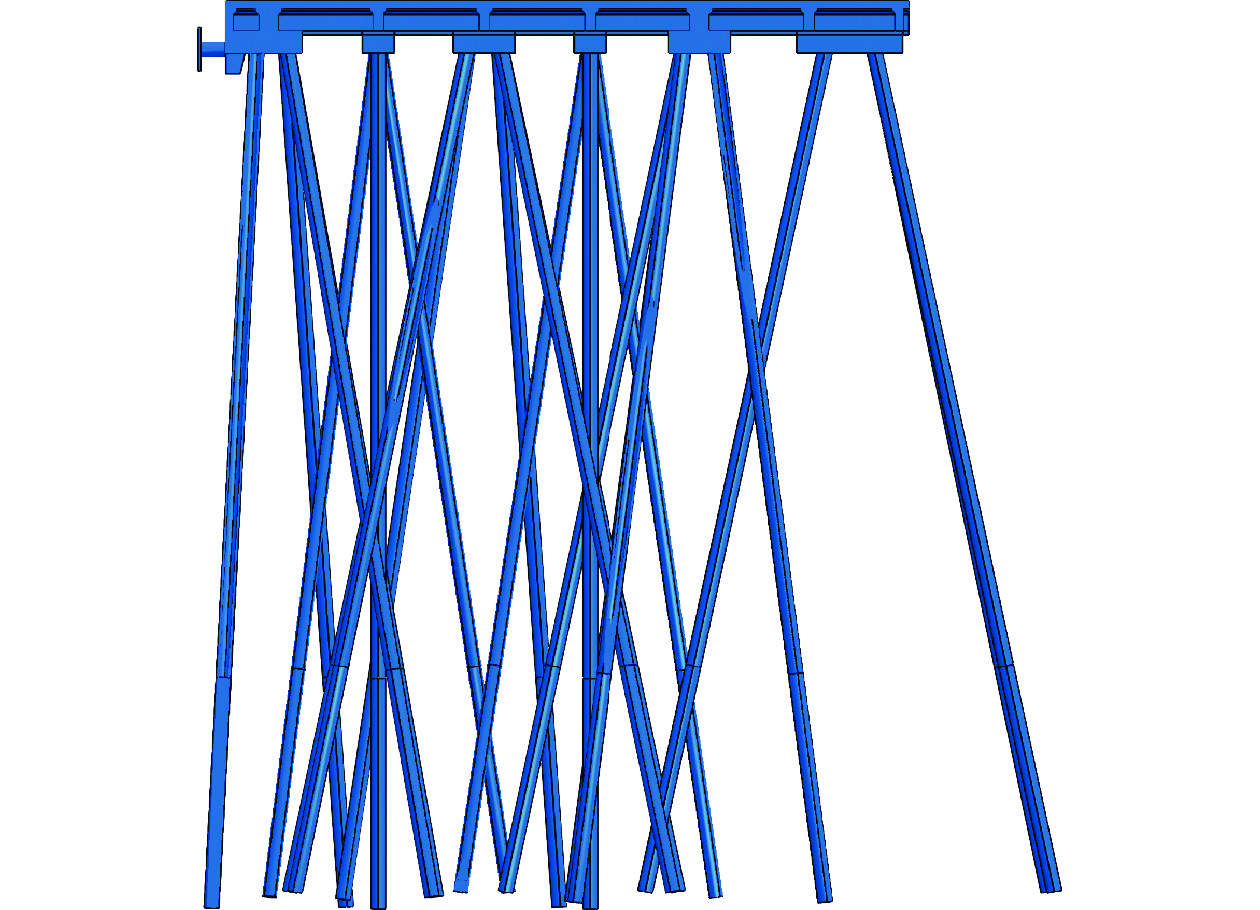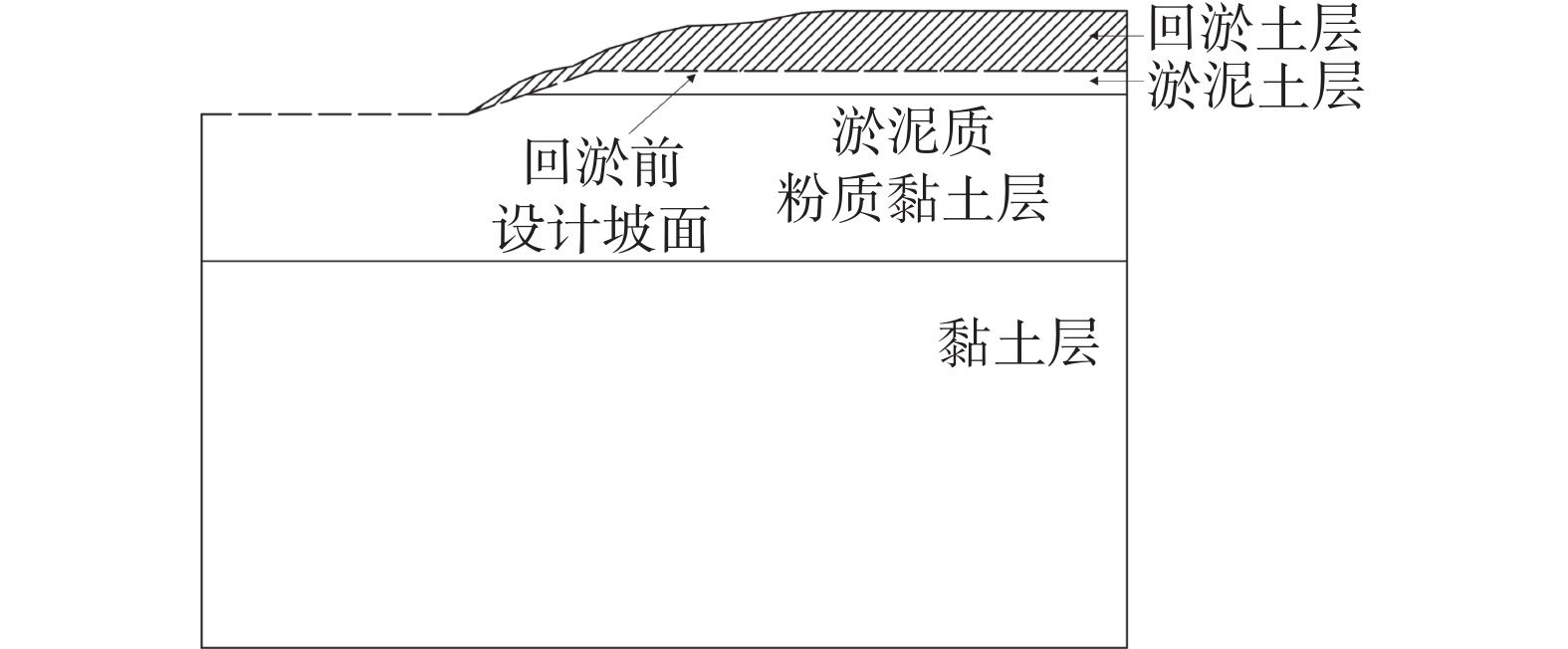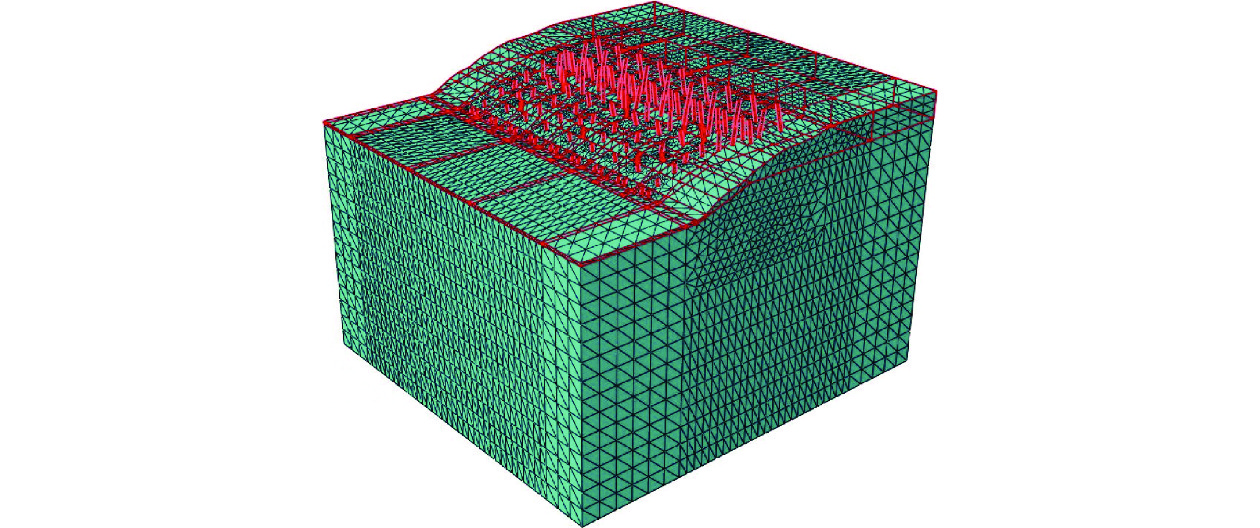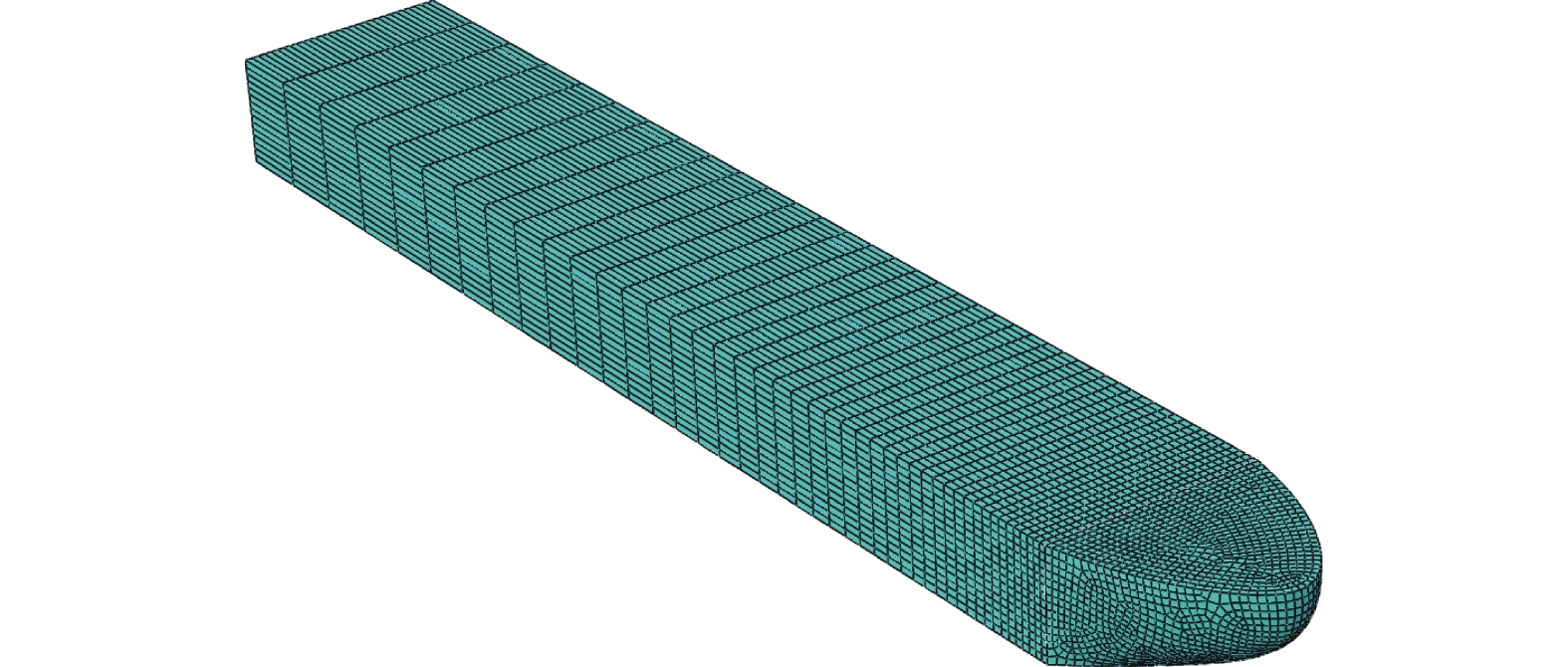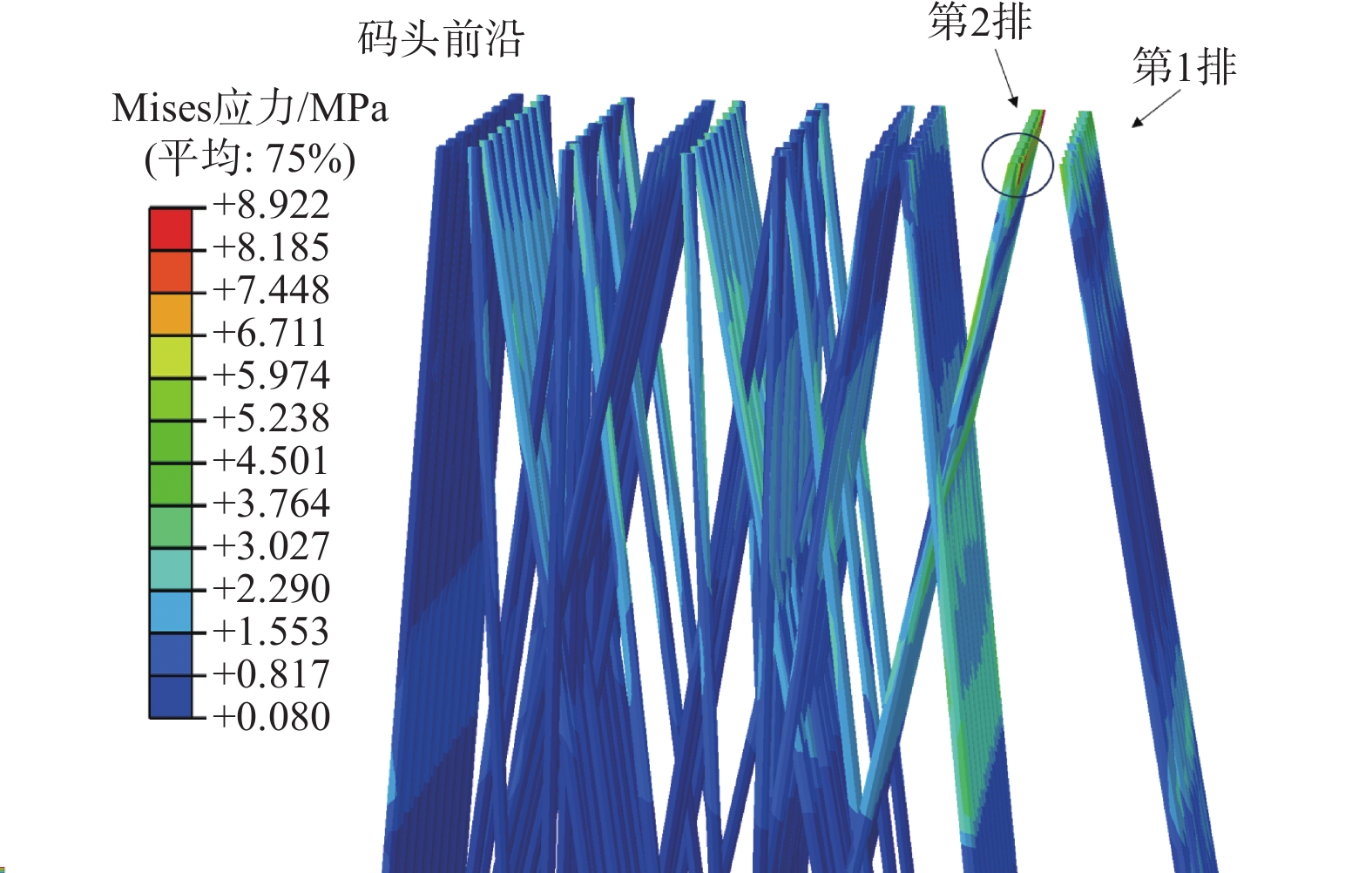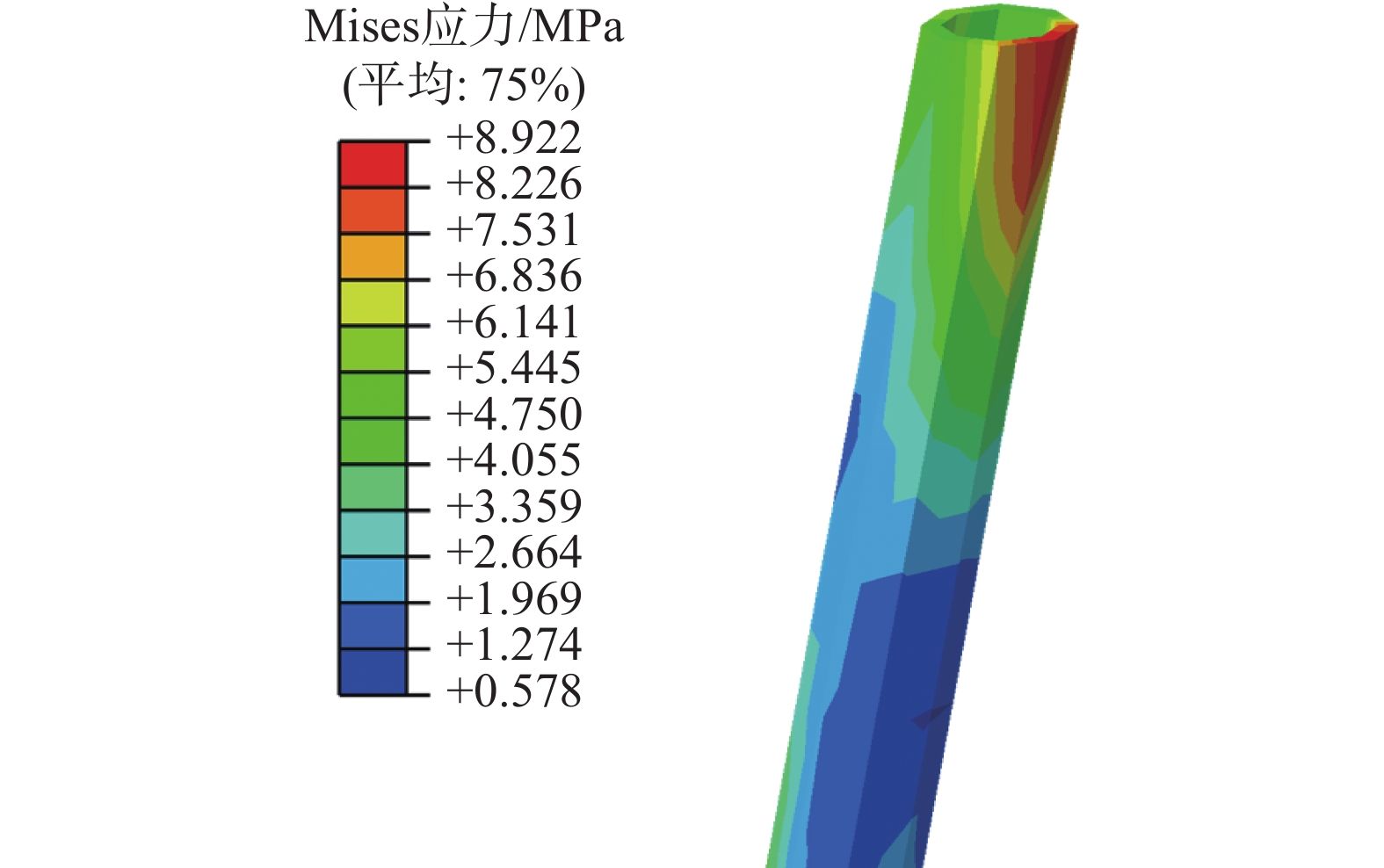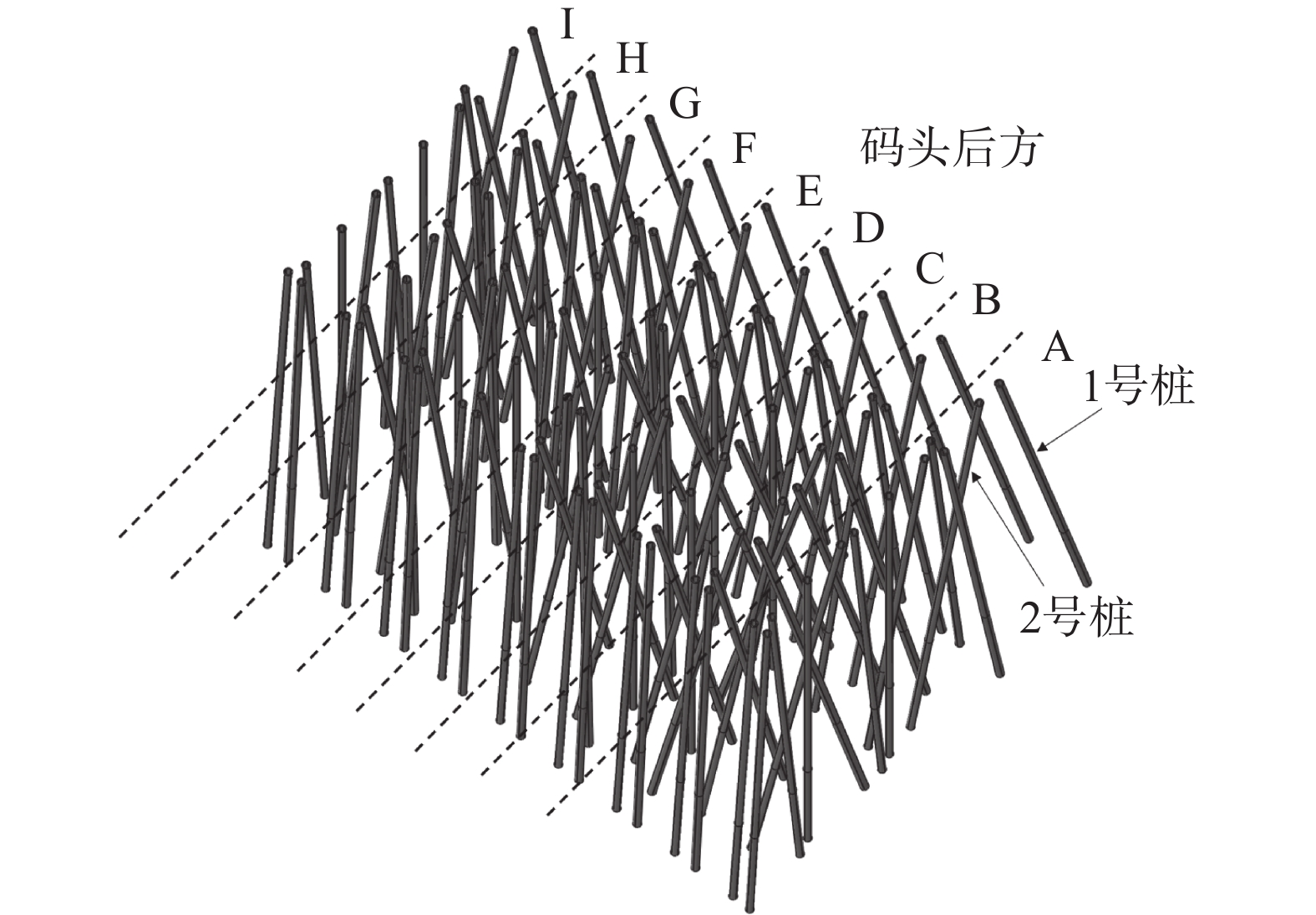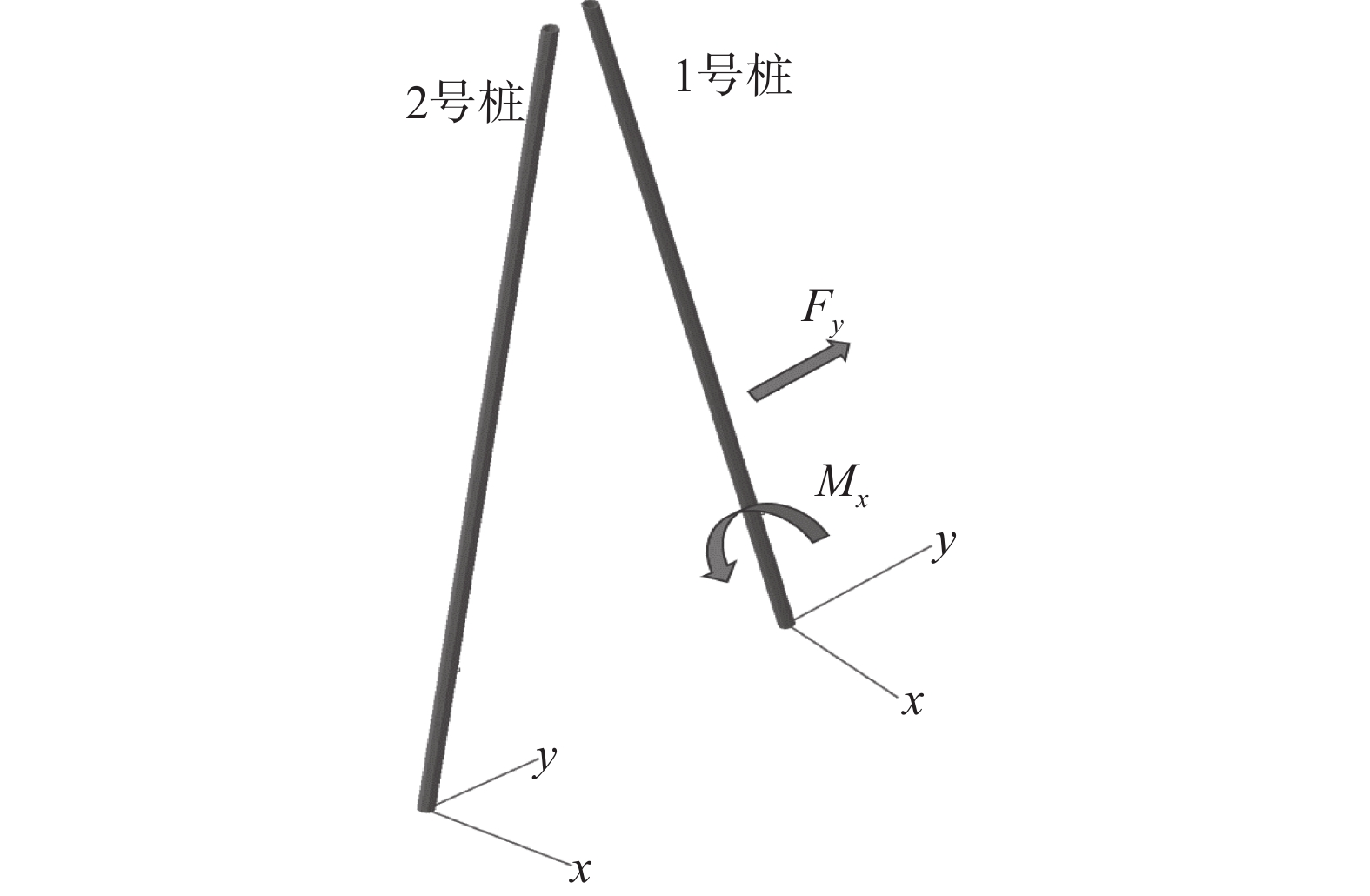Analysis of the impact of sediment siltation and vessel collision on pile foundation stress in high-pile wharves
-
摘要:
中国部分高桩码头下方存在较大的泥沙淤积,且初始设计时并未考虑淤积的影响,较大淤积时淤积土体及船舶撞击会对码头桩基受力产生耦合影响。建立了船舶撞击-上部结构-桩基-土体相互作用的三维有限元数值模型,模拟分析回淤土体和船舶撞击作用对高桩码头桩基受力的影响。结果表明,土体淤积严重位置处的桩顶局部最大主应力、剪力、弯矩相较回淤前均增幅较大,淤积土体对桩基受力的影响十分显著。当法向船舶撞击速度为0.1和0.2 m/s时,船舶撞击力对桩基的影响小于回淤土体的影响。码头不同排架之间的桩基受力存在一定差异。码头后方桩基顶部最为危险,桩基顶部弯矩接近混凝土开裂弯矩,导致桩基容易出现开裂损伤。
Abstract:Significant sediment siltation exists beneath certain high-pile wharves in China, which was not accounted for in the initial design. This sediment siltation, combined with vessel collisions, results in a coupling effect on the stress experienced by the pile foundation. A 3D finite element numerical model was established to simulate the interaction between vessel collisions, superstructures, pile foundations, and soil, analyzing the effects of sediment siltation and vessel impacts on pile foundation stress in high-pile wharves. The results indicate that the maximum principal stress, shear force, and bending moment at the pile tops in areas of severe sediment siltation significantly increase compared to pre-siltation conditions, highlighting the critical influence of sediment on pile foundation stress. For vessel collision velocities of 0.1 and 0.2 m/s, the impact of vessel collisions on the pile foundation is less significant than that of the sediment siltation. Variations in stress are observed between different bent frames of the wharf, with the pile foundation tops behind the wharf being most vulnerable, where the bending moment approaches the cracking moment of the concrete, increasing the risk of damage and cracking in the pile foundation.
-
Keywords:
- sediment siltation /
- high-pile wharf /
- vessel collision /
- pile foundation
-
港口高桩码头具有结构轻、透水性好、对软土地基适应性强等优点,广泛分布于粉沙及淤泥质河口及海岸[1]。中国沿海重大港口桩基码头普遍存在桩基损伤问题[2],桩基在特定荷载作用下发生的损伤将影响港口建设、效益和安全运营,成为重大港口维护和管理工作的重点和难点。高桩码头建成后,码头下方岸坡上可能产生不同程度的泥沙淤积。岸坡淤积的欠固结土体所产生的水平推力和负摩阻力使桩身产生弯矩和变形[3],严重时会导致码头桩基出现裂缝甚至破坏。Feng等[4]通过对高桩码头桩基环向裂缝形态、位置和趋势的分析,判断淤积可能是造成桩身开裂的主要原因;张栋等[3]通过数值模拟方法研究了淤积土体对码头桩基变形的影响,发现桩身弯曲导致桩顶处受力最为不利;张振超等[5]分析了不同回淤厚度对桩基的影响情况,认为高桩码头桩后回淤对结构产生不利影响;李荣庆等[6]的分析表明泥沙淤积产生的附加土压力使最大弯矩出现在桩基顶部,且桩基大部分陆侧受拉;张吕华等[7]分析了冲淤演化过程中不同泥面高程对高桩码头桩基的影响,给出了最不利的泥面高程线。为了提高计算效率,已有的淤积土体作用下高桩码头受力研究大多采用单排架模型来计算,该方法不能反映特定荷载作用下不同排架间可能存在的受力差异。
根据以往船舶撞击作用下桩基码头结构或类似结构受力的研究,认为船舶撞击是桩基损伤的重要原因之一[8]。刘利琴等[9]建立了船舶与高桩码头碰撞的数值模型,对船舶以不同速度和角度撞击码头时的结构受力特性进行了分析;周丹[10]对大吨位船舶停靠框架码头的过程进行了研究,讨论了船舶撞击力的变化过程、能量的转化及撞击力对码头结构的影响;陈建峰等[11]模拟了LNG 船与高桩码头的碰撞过程,基于有限元方法对船舶撞击力和有效应力进行计算,并与已有经验公式进行了比较分析;Fan等[12]考虑土体-结构-桩之间的相互作用,对船舶撞击对桩基结构的受力进行了有限元数值模拟。在船舶撞击码头结构过程中,存在船舶、码头上部结构、桩基、地基土体的相互作用。但以往大多研究将土体作用等效为弹簧或者仅考虑桩端截面以上的土体,未能充分考虑桩身与土体间的接触、滑移等相互作用。
以上研究对深入认识船舶、桩基结构、土体相互作用有着重要意义,然而,中国部分桩基码头下方存在较大的泥沙淤积,且初始设计时并未考虑淤积的影响,较大淤积时存在淤积土体及船舶撞击对码头桩基受力的耦合影响。为此,本文建立船舶撞击-上部结构-桩基-土体相互作用的三维有限元数值模型,分析回淤与船舶撞击对高桩码头桩基受力的影响。
1. 有限元模型的建立
1.1 数值模型
以浙江宁波某码头为例通过ABAQUS建立有限元数值模型,图1为高桩码头结构模型。码头结构采用高桩梁板式结构,结构段长90.0 m,宽55.5 m,由面板、横梁、纵梁、桩帽和桩基组成。码头顶面高程为5.20 m,码头前沿泥面设计高程为−17.50 m。结构段共9个横向排架,排架间距10.5 m,码头结构分为上部结构和桩基两部分(图2),其中上部结构包括现浇桩帽、预制横梁和纵向梁、预制现浇叠合面板结构,横梁长55.5 m,纵梁长90.0 m,面板厚0.6 m,桩帽厚1.92 m,混凝土材料等级为C30。数值模型中上部结构采用八结点六面体网格单元,最小网格尺寸为0.07 m。下方桩基共114根,总长76 m,其中每根桩上部56 m的范围内为外径1 200 mm、内径910 mm的混凝土管桩结构,混凝土材料等级为C60。模型中桩基也采用八结点六面体网格单元,最小网格尺寸为0.145 m。上部结构的桩帽与桩之间采用固结的边界条件进行约束。
码头前沿每隔21 m设置1组2000H鼓型橡胶护舷(一鼓一板),橡胶护舷模型由橡胶本体和防冲板结构组成,橡胶本体简化为长2.0 m、直径1.38 m的圆柱体结构,防冲板简化为3.8 m×2.4 m ×0.25 m的长方体结构。
回淤前土体根据实测资料简化成3层(图3),分别是淤泥土层、淤泥质粉质黏土层和黏土层。淤泥土层厚度为3.5 m,淤泥质粉质黏土层厚25.0 m,粉质黏土层厚85.0 m,岸坡坡度为1∶3。该码头下方岸坡自建设后出现了较大的泥沙淤积,淤积土体实测最大厚度可达9.0 m,根据实测资料对回淤后的边坡进行简化(图3)。回淤后的土体固结在回淤前土体模型表面,模型中土体部分采用四结点线性四面体单元,在桩附近网格最密,最小网格尺寸为0.30 m(图4)。土体模型区域范围沿码头岸线方向长130.0 m,垂向于码头岸线方向宽139.5 m,在垂直码头岸线方向上土体模型边界距离高桩码头结构两侧均为40 m,在平行码头岸线方向上边界距离码头结构均为20 m。根据刘建宇等[13]的研究,认为该距离设置可以消除土体边界效应的影响。
图5为20万t级集装箱船模型,其主要尺寸根据《海港总体设计规范》[14]确定。在本文所建立的模型中,为简化计算,主要考虑船艏结构与高桩码头的橡胶护舷结构的碰撞,二者产生变形并吸收能量。根据周丹[10]的方法,对船体模型进行适当简化,将船艏结构等效为壳体单元,将船艏结构固结在船身上,并对船艏结构的网格进行加密处理。
1.2 参数设置
对于钢筋混凝土材料,Fan等[12,15-16]认为在研究极端情况下的破坏模式时,可近似用混凝土的弹性模量来代替钢筋混凝土的弹性模量。根据上述研究,码头桩基结构材料参数的取值与对应混凝土等级的弹性模量相等,参照《混凝土结构设计规范》[17]设置力学参数(表1)。回淤前与回淤后各土层参数均根据现场土样试验结果给出,其中,弹性模量取为压缩模量的8倍[18-19],密度取各土层的水下有效密度,未考虑回淤过程中的强度增长。船体材料的力学参数根据陈建峰等[11-12,20-21]的研究给出。橡胶护舷材料选用各向同性的超弹性材料,应变势能函数采用Mooney-Rivlin 模型,根据冯森等[21-23]的研究设定参数。各部分的材料参数设置见表1。
表 1 模型材料参数Table 1. Material parameters of the model结构/材料 密度/(kg/m3) 弹性模量/MPa 泊松比 黏聚力/kPa 内摩擦角/(°) C10/Pa C01/Pa 船艏 7 800 2.1×105 0.300 船身 413 2.0×105 0.300 码头上部结构 2 360 3.0×104 0.200 桩基 2 500 3.6×104 0.167 回淤土 1 650 19.28 0.350 11.9 7.7 淤泥土 1 660 18.64 0.350 13.0 7.9 淤泥质粉质黏土 1 780 23.44 0.300 17.0 9.3 黏土 1 880 33.92 0.250 25.0 12.1 橡胶护舷 1 800 0.490 5.5×108 1.4×108 注:表中C10和C01为两参数Mooney-Rivlin 模型中的Rivlin系数。 对于船舶撞击,主要分析靠泊过程中对码头的撞击。根据《港口工程荷载规范》[24],船舶撞击码头时法向速度选取为0.1和0.2 m/s。在数值模拟计算时,先平衡土体地应力和码头结构自重,然后通过动力显示算法求解船舶撞击的瞬时动力过程。
模型中桩与土、船与护弦的相互作用采用接触算法,接触类型均按表面与表面接触处理[25]。桩土接触中滑移公式选择小滑移,接触作用属性中法向行为采用“硬”接触,只有在模型单元处于压紧状态时才能传递法向压力,有间隙时则不传递法向压力,即接触算法受拉可脱离。切向行为中采用罚函数方法,回淤前土层摩擦系数为0.12,回淤土层摩擦系数取为0.10[25]。
1.3 计算工况
为研究码头下方存在较大泥沙淤积时淤积土体和船舶撞击对码头桩基受力的影响,分别对不同回淤条件和船舶撞击条件下的工况进行模拟计算(表2)。
表 2 计算工况Table 2. Calculation conditions工况 回淤条件 码头结构受载情况 撞击条件 1 回淤前 淤泥土层产生的水平推力和负摩阻力作用 无船舶撞击 2 回淤后 回淤和淤泥土层共同产生的水平推力和负摩阻力作用 无船舶撞击 3 回淤后 回淤和淤泥土层共同产生的水平推力、负摩阻力作用与船舶撞击力 船舶以0.1 m/s的法向速度撞击 4 回淤后 回淤和淤泥土层共同产生的水平推力、负摩阻力作用与船舶撞击力 船舶以0.2 m/s的法向速度撞击 2. 结果分析与讨论
2.1 数值模型验证
利用Chu等[26]船舶撞击桩基结构的离心机试验结果,对本文建模方法进行验证。图6为船舶撞击桩基结构过程中不同时刻桩基弯矩分布的数值模拟与试验结果对比,可以看出数值模拟结果与试验结果吻合较好。
2.2 不同排架桩基内力差异
图7为回淤后船舶以0.1 m/s的法向速度撞击高桩码头时桩基等效应力计算结果,图8为等效应力最大位置处的计算结果(图7中圆圈位置)。从图7、图8可以看出,在船舶靠泊撞击高桩码头的过程中,码头后方两排桩的顶部位置靠陆侧的应力较大,为整个桩基结构中最危险的区域。
图9为不同横向排架的编号,从右到左由排架A至排架I。表3为不同排架间码头后方两排桩的最大剪力和最大弯矩。从图7和表3可以看出,不同排架间桩顶最大剪力和最大弯矩均出现在图9中1号桩和2号桩位置处,不同排架之间最大剪力和最大弯矩的差值在后方第1排桩最高分别可达19%和24%,在后方第2排桩最高分别可达19%和22%。
表 3 不同排架的最大剪力和最大弯矩Table 3. Maximum shear force and bending moment for different bent frames位置 排架编号 桩顶最大剪力/kN 桩顶最大弯矩/(kN·m) 位置 排架编号 桩顶最大剪力/kN 桩顶最大弯矩/(kN·m) 后方第1排 A 97 511 后方第2排 A 183 715 B 88 466 B 169 646 C 81 401 C 155 585 D 80 388 D 152 567 E 78 391 E 150 560 F 78 392 F 148 557 G 82 403 G 153 580 H 88 464 H 164 635 I 94 502 I 179 705 为便于分析,主要对其中最危险区域进行讨论,即主要针对图9中1号和2号桩进行分析。
2.3 下方淤积与船舶撞击对桩基应力的影响
表4为1号和2号桩在回淤前无船舶撞击、回淤后无船舶靠泊撞击及回淤后船舶以0.1和0.2 m/s的法向速度撞击等不同工况下的最大主应力。无船舶撞击时2号桩最大主应力回淤后相较回淤前增大99%。回淤后桩受到的应力增加,主要原因是厚度较大的回淤土体对桩基产生向海侧的土压力,在该土压力荷载作用下桩基应力增加。回淤后,1号桩最大主应力有船舶靠泊撞击时相较无船舶撞击时增大9%,2号桩最大主应力有船舶撞击时相较无船舶撞击时增大24%,船舶撞击使得桩基应力在淤积土体影响的基础上继续增大。
表 4 桩基在不同计算工况下的最大主应力Table 4. Maximum principal stress of the pile foundation under different calculation conditions序号 桩位 回淤条件 撞击条件 最大主应力/MPa 1 1号桩 回淤前 无船舶撞击 −0.858 2 1号桩 回淤后 无船舶撞击 1.030 3 1号桩 回淤后 船舶以0.1 m/s的法向速度撞击 1.126 4 1号桩 回淤后 船舶以0.2 m/s的法向速度撞击 1.118 5 2号桩 回淤前 无船舶撞击 1.682 6 2号桩 回淤后 无船舶撞击 3.339 7 2号桩 回淤后 船舶以0.1 m/s的法向速度撞击 4.156 8 2号桩 回淤后 船舶以0.2 m/s的法向速度撞击 4.134 1号桩和2号桩所在位置处淤积土体厚度达9.0 m,桩身部分和桩周土体的相互作用受淤积土影响效果十分明显,桩基顶部一侧受拉一侧受压,回淤后局部最大主应力相比回淤前成倍增加。在回淤土作用的基础上,对于0.1和0.2 m/s的船舶撞击速度,撞击速度对最大主应力的影响较小,船舶靠泊撞击对桩基应力产生的影响小于淤积土体的影响。
2.4 下方淤积与船舶撞击对桩基剪力的影响
图10为不同回淤和船舶撞击条件下1号桩和2号桩的剪力分量Fy,其中回淤后有船舶撞击时的结果为桩身剪力历时最大时刻的结果。图11为局部坐标系下剪力与弯矩分量示意图,局部坐标系的z轴与桩轴线重合,x轴平行于码头岸线,剪力分量Fy指向岸一侧。以桩身某横截面以下桩身为研究对象,剪力为正代表剪力的方向指向陆地一侧,剪力为负代表剪力的方向指向海水一侧,z坐标值为沿桩轴线各截面位置到桩尖的距离。
由图10可见,1号桩和2号桩下部的剪力在回淤后相较于回淤前变化较小,而桩顶位置处剪力增大明显,但是,1号桩和2号桩桩顶剪力增幅不同,这主要是因为两根桩倾斜方向不一致,淤积土体引起的附加土压力不同,从而导致两根桩的剪力变化幅度不一样。无船舶撞击时1号与2号桩桩顶剪力回淤后相较回淤前分别增大262% 和421%。码头下方发生淤积后,1号桩桩顶剪力有船舶撞击时相较无船舶撞击时减小14%,2号桩桩顶剪力有船舶撞击时相较无船舶撞击时增大9%。回淤后1号桩和2号桩桩顶剪力受船舶撞击的影响不一致,主要是两根桩的倾斜方向不一致,回淤土体与船舶撞击对桩顶部剪力的影响相反。同时可见,在回淤土作用基础上,对于0.1和0.2 m/s的船舶撞击速度,撞击速度对桩顶剪力的影响较小,船舶撞击对桩基剪力的影响小于淤积土体的影响。
表5为不同工况下1号与2号桩最大合剪力计算结果。C60等级混凝土的抗剪强度设计值为3.1 MPa, 按大管桩结构上部截面面积0.481 m2估算,其对应剪力极限值为1 490 kN。根据表5结果,回淤前后桩基顶部剪力较大位置处均未出现剪切破坏。
表 5 桩基在不同计算工况下的最大剪力Table 5. Maximum shear force of the pile foundation under different calculation conditions序号 桩位 回淤条件 撞击条件 最大剪力/kN 1 1号桩 回淤前 无船舶撞击 45 2 1号桩 回淤后 无船舶撞击 110 3 1号桩 回淤后 船舶以0.1 m/s的法向速度撞击 109 4 1号桩 回淤后 船舶以0.2 m/s的法向速度撞击 106 5 2号桩 回淤前 无船舶撞击 53 6 2号桩 回淤后 无船舶撞击 146 7 2号桩 回淤后 船舶以0.1 m/s的法向速度撞击 195 8 2号桩 回淤后 船舶以0.2 m/s的法向速度撞击 194 2.5 下方淤积与船舶撞击对桩基弯矩的影响
图12为不同回淤和船舶撞击条件下1号桩和2号桩的弯矩分量Mx,其中回淤后有船舶撞击时的结果为桩身弯矩历时最大时刻的结果。弯矩分量Mx为绕局部坐标系x轴的弯矩分量(见图11)。弯矩为正代表桩身向陆一侧受拉、向海一侧受压,弯矩为负代表桩身向海一侧受拉、向陆一侧受压,图12中z坐标值为沿桩轴线各截面位置到桩尖的距离。
从图12可以看出,桩基下部的弯矩在回淤后相较于回淤前变化较小,最大弯矩出现在桩基顶部,回淤后桩顶弯矩相比回淤前明显增大。无船舶撞击时,1号和2号桩顶弯矩回淤后相较回淤前分别增大188%和219%。码头下方发生淤积后,有船舶撞击时1号桩顶弯矩相较无船舶撞击减小12%,而2号桩最大弯矩有船舶撞击时相较无船舶撞击时增大3%。1号和2号桩最大弯矩受船舶撞击的影响不一致,主要是泥沙淤积引起的附加土压力不同,两根桩的倾斜方向不一致,回淤土体与船舶撞击对桩顶部弯矩的影响相反。在回淤土作用的基础上,对于0.1和0.2 m/s的船舶撞击速度,撞击速度对桩顶弯矩的影响较小,船舶撞击对桩基弯矩产生的影响小于淤积土体的影响。
表6为不同工况下1号与2号桩最大合弯矩计算结果。根据实验室资料,所采用的混凝土大管桩的开裂弯矩为1 158 kN·m。根据表6结果,1号桩和2号桩的弯矩最大值在回淤前后均未达到开裂弯矩,但回淤后弯矩最大值已达到开裂弯矩的60%以上,再叠加其他因素后桩基容易出现开裂损伤。
表 6 桩基在不同计算工况下的最大弯矩Table 6. Maximum bending moment of the pile foundation under different calculation conditions序号 桩位 回淤条件 撞击条件 最大弯矩/(kN·m) 1 1号桩 回淤前 无船舶撞击 309 2 1号桩 回淤后 无船舶撞击 539 3 1号桩 回淤后 船舶以0.1 m/s的法向速度撞击 546 4 1号桩 回淤后 船舶以0.2 m/s的法向速度撞击 542 5 2号桩 回淤前 无船舶撞击 318 6 2号桩 回淤后 无船舶撞击 618 7 2号桩 回淤后 船舶以0.1 m/s的法向速度撞击 743 8 2号桩 回淤后 船舶以0.2 m/s的法向速度撞击 740 3. 结 语
针对高桩码头下方存在较大淤积时淤积与船舶撞击对桩基受力的影响,建立了船舶撞击-上部结构-桩基-土体相互作用的三维有限元数值模型,模拟分析了船舶以0.1和0.2 m/s法向速度撞击和回淤土体对码头桩基受力的影响,主要结论如下:
(1)码头后方两排桩的顶部位置处靠陆侧的应力较大,为整个桩基结构中最危险的区域。不同排架之间桩顶的最大剪力和最大弯矩在数值上存在一定差异,对于回淤土体和速度为0.1 m/s船舶撞击共同作用的情况下,最大相差约20%。
(2)码头下方存在较大淤积时,回淤土体对桩基产生向海侧的土压力,在回淤土体土压力作用下,桩顶局部最大主应力与最大剪力相比回淤前都明显增加,最大主应力回淤后相较回淤前平均增大1倍,最大剪力回淤后相较回淤前平均增大3~4倍。
(3)码头下方存在较大淤积时,由于回淤土体的水平土压力作用,桩身下部所受弯矩变化不大,桩顶局部最大弯矩相比回淤前明显增大,最大弯矩回淤后相较回淤前平均增大2倍,回淤后弯矩最大值接近开裂弯矩,容易造成开裂损伤。
(4)在回淤土作用的基础上,对于0.1和0.2 m/s的船舶撞击速度,撞击速度对桩基受力的影响较小,船舶撞击对桩基受力产生的影响远小于淤积土体的作用。
-
表 1 模型材料参数
Table 1 Material parameters of the model
结构/材料 密度/(kg/m3) 弹性模量/MPa 泊松比 黏聚力/kPa 内摩擦角/(°) C10/Pa C01/Pa 船艏 7 800 2.1×105 0.300 船身 413 2.0×105 0.300 码头上部结构 2 360 3.0×104 0.200 桩基 2 500 3.6×104 0.167 回淤土 1 650 19.28 0.350 11.9 7.7 淤泥土 1 660 18.64 0.350 13.0 7.9 淤泥质粉质黏土 1 780 23.44 0.300 17.0 9.3 黏土 1 880 33.92 0.250 25.0 12.1 橡胶护舷 1 800 0.490 5.5×108 1.4×108 注:表中C10和C01为两参数Mooney-Rivlin 模型中的Rivlin系数。 表 2 计算工况
Table 2 Calculation conditions
工况 回淤条件 码头结构受载情况 撞击条件 1 回淤前 淤泥土层产生的水平推力和负摩阻力作用 无船舶撞击 2 回淤后 回淤和淤泥土层共同产生的水平推力和负摩阻力作用 无船舶撞击 3 回淤后 回淤和淤泥土层共同产生的水平推力、负摩阻力作用与船舶撞击力 船舶以0.1 m/s的法向速度撞击 4 回淤后 回淤和淤泥土层共同产生的水平推力、负摩阻力作用与船舶撞击力 船舶以0.2 m/s的法向速度撞击 表 3 不同排架的最大剪力和最大弯矩
Table 3 Maximum shear force and bending moment for different bent frames
位置 排架编号 桩顶最大剪力/kN 桩顶最大弯矩/(kN·m) 位置 排架编号 桩顶最大剪力/kN 桩顶最大弯矩/(kN·m) 后方第1排 A 97 511 后方第2排 A 183 715 B 88 466 B 169 646 C 81 401 C 155 585 D 80 388 D 152 567 E 78 391 E 150 560 F 78 392 F 148 557 G 82 403 G 153 580 H 88 464 H 164 635 I 94 502 I 179 705 表 4 桩基在不同计算工况下的最大主应力
Table 4 Maximum principal stress of the pile foundation under different calculation conditions
序号 桩位 回淤条件 撞击条件 最大主应力/MPa 1 1号桩 回淤前 无船舶撞击 −0.858 2 1号桩 回淤后 无船舶撞击 1.030 3 1号桩 回淤后 船舶以0.1 m/s的法向速度撞击 1.126 4 1号桩 回淤后 船舶以0.2 m/s的法向速度撞击 1.118 5 2号桩 回淤前 无船舶撞击 1.682 6 2号桩 回淤后 无船舶撞击 3.339 7 2号桩 回淤后 船舶以0.1 m/s的法向速度撞击 4.156 8 2号桩 回淤后 船舶以0.2 m/s的法向速度撞击 4.134 表 5 桩基在不同计算工况下的最大剪力
Table 5 Maximum shear force of the pile foundation under different calculation conditions
序号 桩位 回淤条件 撞击条件 最大剪力/kN 1 1号桩 回淤前 无船舶撞击 45 2 1号桩 回淤后 无船舶撞击 110 3 1号桩 回淤后 船舶以0.1 m/s的法向速度撞击 109 4 1号桩 回淤后 船舶以0.2 m/s的法向速度撞击 106 5 2号桩 回淤前 无船舶撞击 53 6 2号桩 回淤后 无船舶撞击 146 7 2号桩 回淤后 船舶以0.1 m/s的法向速度撞击 195 8 2号桩 回淤后 船舶以0.2 m/s的法向速度撞击 194 表 6 桩基在不同计算工况下的最大弯矩
Table 6 Maximum bending moment of the pile foundation under different calculation conditions
序号 桩位 回淤条件 撞击条件 最大弯矩/(kN·m) 1 1号桩 回淤前 无船舶撞击 309 2 1号桩 回淤后 无船舶撞击 539 3 1号桩 回淤后 船舶以0.1 m/s的法向速度撞击 546 4 1号桩 回淤后 船舶以0.2 m/s的法向速度撞击 542 5 2号桩 回淤前 无船舶撞击 318 6 2号桩 回淤后 无船舶撞击 618 7 2号桩 回淤后 船舶以0.1 m/s的法向速度撞击 743 8 2号桩 回淤后 船舶以0.2 m/s的法向速度撞击 740 -
[1] LIU Y, CHEN J T, LI W. Research on the application of pile-bucket composite structure in the silt coast[J]. Stavební Obzor-Civil Engineering Journal, 2022, 31(3): 467-483.
[2] 李龙. 沿海高桩码头主体结构耐久性影响因素分析[J]. 工程技术研究,2020,5(20):103-104. (LI Long. Analysis of influencing factors on durability of main structure of coastal high-piled wharf[J]. Engineering and Technological Research, 2020, 5(20): 103-104. (in Chinese) LI Long. Analysis of influencing factors on durability of main structure of coastal high-piled wharf[J]. Engineering and Technological Research, 2020, 5(20): 103-104. (in Chinese)
[3] 张栋, 张龙, 刘欣昕, 等. 后方土体淤积下高桩码头桩基变形规律分析[J]. 水资源与水工程学报,2022,33(1):159-163, 170. (ZHANG Dong, ZHANG Long, LIU Xinxin, et al. Deformation response of a high piled wharf foundation in the process of slope siltation[J]. Journal of Water Resources and Water Engineering, 2022, 33(1): 159-163, 170. (in Chinese) ZHANG Dong, ZHANG Long, LIU Xinxin, et al. Deformation response of a high piled wharf foundation in the process of slope siltation[J]. Journal of Water Resources and Water Engineering, 2022, 33(1): 159-163, 170. (in Chinese)
[4] FENG Y, WU Y, LI S N, et al. Study on the causes and countermeasures of pile cracking at an in-service high-piled wharf[M]. Advances in Traffic Transportation and Civil Architecture. London: CRC Press, 2023: 794-799.
[5] 张振超, 李慧娣. 高桩码头桩后回淤对桩的影响数值分析[J]. 港工技术,2021,58(1):54-58. (ZHANG Zhenchao, LI Huidi. Numerical analysis for influence of siltation on piled berth structure[J]. Port Engineering Technology, 2021, 58(1): 54-58. (in Chinese) ZHANG Zhenchao, LI Huidi. Numerical analysis for influence of siltation on piled berth structure[J]. Port Engineering Technology, 2021, 58(1): 54-58. (in Chinese)
[6] 李荣庆, 侯永为. 考虑泥沙淤积影响的高桩码头三维有限元分析[J]. 水运工程,2016(10):95-99. (LI Rongqing, HOU Yongwei. Three-dimensional finite element analysis of pile-supported wharf considering sediment deposition[J]. Port & Waterway Engineering, 2016(10): 95-99. (in Chinese) doi: 10.3969/j.issn.1002-4972.2016.10.018 LI Rongqing, HOU Yongwei. Three-dimensional finite element analysis of pile-supported wharf considering sediment deposition[J]. Port & Waterway Engineering, 2016(10): 95-99. (in Chinese) doi: 10.3969/j.issn.1002-4972.2016.10.018
[7] 张吕华, 李凯, 夏剑, 等. 码头后方冲淤演化对桩基础影响分析与研究[J]. 中国水运,2022,22(9):105-107. (ZHANG Lühua, LI Kai, XIA Jian, et al. Analysis and research on the impact of erosion and sedimentation evolution behind the dock on pile foundations[J]. China Water Transport, 2022, 22(9): 105-107. (in Chinese) ZHANG Lühua, LI Kai, XIA Jian, et al. Analysis and research on the impact of erosion and sedimentation evolution behind the dock on pile foundations[J]. China Water Transport, 2022, 22(9): 105-107. (in Chinese)
[8] ZHENG Y L, ZHANG R X. Experimental study on the damage characteristic and assessment of transverse bent frame of high-piled wharf under impact load[J]. Developments in the Built Environment, 2023, 14: 100124. doi: 10.1016/j.dibe.2023.100124
[9] 刘利琴, 陈建峰, 罗超, 等. 高桩码头在船舶撞击下的动力响应及损伤分析[J]. 哈尔滨工程大学学报,2023,44(4):519-526. (LIU Liqin, CHEN Jianfeng, LUO Chao, et al. Dynamic response and damage analysis of high-piled wharves under ship impact[J]. Journal of Harbin Engineering University, 2023, 44(4): 519-526. (in Chinese) LIU Liqin, CHEN Jianfeng, LUO Chao, et al. Dynamic response and damage analysis of high-piled wharves under ship impact[J]. Journal of Harbin Engineering University, 2023, 44(4): 519-526. (in Chinese)
[10] 周丹. 船舶停靠码头撞击力研究[J]. 港工技术,2022,59(2):27-31. (ZHOU Dan. Research on impact force caused by ships lying at berth[J]. Port Engineering Technology, 2022, 59(2): 27-31. (in Chinese) ZHOU Dan. Research on impact force caused by ships lying at berth[J]. Port Engineering Technology, 2022, 59(2): 27-31. (in Chinese)
[11] 陈建峰, 沈文君, 刘利琴, 等. LNG船与高桩码头碰撞的力学特性[J]. 船舶工程,2021,43(8):57-62. (CHEN Jianfeng, SHEN Wenjun, LIU Liqin, et al. Mechanical characteristics of collision between LNG ship and piled wharf[J]. Ship Engineering, 2021, 43(8): 57-62. (in Chinese) CHEN Jianfeng, SHEN Wenjun, LIU Liqin, et al. Mechanical characteristics of collision between LNG ship and piled wharf[J]. Ship Engineering, 2021, 43(8): 57-62. (in Chinese)
[12] FAN W, YUAN W C. Numerical simulation and analytical modeling of pile-supported structures subjected to ship collisions including soil-structure interaction[J]. Ocean Engineering, 2014, 91: 11-27. doi: 10.1016/j.oceaneng.2014.08.011
[13] 刘建宇, 王春艳, 刘冒佚, 等. 钙质砂中单桩水平承载特性模型试验研究[J]. 土木与环境工程学报(中英文),2021,43(6):74-81. (LIU Jianyu, WANG Chunyan, LIU Maoyi, et al. Horizontal loading model test of single pile in calcareous sand[J]. Journal of Civil and Environmental Engineering, 2021, 43(6): 74-81. (in Chinese) LIU Jianyu, WANG Chunyan, LIU Maoyi, et al. Horizontal loading model test of single pile in calcareous sand[J]. Journal of Civil and Environmental Engineering, 2021, 43(6): 74-81. (in Chinese)
[14] 中华人民共和国交通运输部. 海港总体设计规范: JTS 165—2013[S]. 北京: 人民交通出版社, 2013. (Ministry of Transport of the People’s Republic of China. Design code of general layout for sea ports: JTS 165-2013 [S]. Beijing: China Communications Press, 2013. (in Chinese) Ministry of Transport of the People’s Republic of China. Design code of general layout for sea ports: JTS 165-2013 [S]. Beijing: China Communications Press, 2013. (in Chinese)
[15] 魏金源, 厉帅, 张勇, 等. 基于ABAQUS的钢纤维/钢筋混凝土落锤冲击试验数值模拟[J]. 四川水泥, 2017(5): 148, 213. (WEI Jinyuan, LI Shuai, ZHANG Yong, et al. Numerical simulation of steel fiber/reinforced concrete drop hammer impact test based on ABAQUS[J]. Sichuan Cement, 2017(5): 148, 213. (in Chinese) WEI Jinyuan, LI Shuai, ZHANG Yong, et al. Numerical simulation of steel fiber/reinforced concrete drop hammer impact test based on ABAQUS[J]. Sichuan Cement, 2017(5): 148, 213. (in Chinese)
[16] 高鸿富. 混凝土弹性模量在钢筋混凝土预应力混凝土结构设计中的应用[J]. 港工技术通讯,1978(2):56-71. (GAO Hongfu. Application of concrete elastic modulus in the design of reinforced concrete prestressed concrete structures[J]. Port Engineering Technology, 1978(2): 56-71. (in Chinese) GAO Hongfu. Application of concrete elastic modulus in the design of reinforced concrete prestressed concrete structures[J]. Port Engineering Technology, 1978(2): 56-71. (in Chinese)
[17] 中华人民共和国住房和城乡建设部. 混凝土结构设计规范: GB 50010—2010[S]. 北京: 中国建筑工业出版社, 2010. (Ministry of Housing and Urban Rural Development of the People’s Republic of China. Code for design of concrete structures: GB 50010-2010[S]. Beijing: China Architecture & Building Press, 2010. (in Chinese) Ministry of Housing and Urban Rural Development of the People’s Republic of China. Code for design of concrete structures: GB 50010-2010[S]. Beijing: China Architecture & Building Press, 2010. (in Chinese)
[18] 杨敏, 朱碧堂. 堆载下土体侧移及对邻桩作用的有限元分析[J]. 同济大学学报(自然科学版),2003,31(7):772-777. (YANG Min, ZHU Bitang. Finite element method used in modeling lateral soil movement due to surcharge loads and its effect on adjacent piles[J]. Journal of Tongji University (Natural Science), 2003, 31(7): 772-777. (in Chinese) YANG Min, ZHU Bitang. Finite element method used in modeling lateral soil movement due to surcharge loads and its effect on adjacent piles[J]. Journal of Tongji University (Natural Science), 2003, 31(7): 772-777. (in Chinese)
[19] 贾堤, 石峰, 郑刚, 等. 深基坑工程数值模拟土体弹性模量取值的探讨[J]. 岩土工程学报,2008,30(增刊1):155-158. (JIA Di, SHI Feng, ZHENG Gang, et al. Elastic modulus of soil used in numerical simulation of deep foundation pits[J]. Chinese Journal of Geotechnical Engineering, 2008, 30(Suppl1): 155-158. (in Chinese) JIA Di, SHI Feng, ZHENG Gang, et al. Elastic modulus of soil used in numerical simulation of deep foundation pits[J]. Chinese Journal of Geotechnical Engineering, 2008, 30(Suppl1): 155-158. (in Chinese)
[20] 杨兴晏. 关于船舶排水量与船舶载重吨的回归分析[J]. 港工技术,2008(1):17-18. (YANG Xingyan. The regression analysis about ship displacement and ship deadweight[J]. Port Engineering Technology, 2008(1): 17-18. (in Chinese) YANG Xingyan. The regression analysis about ship displacement and ship deadweight[J]. Port Engineering Technology, 2008(1): 17-18. (in Chinese)
[21] 冯森. 船舶撞击高桩码头结构的动力响应分析[D]. 镇江: 江苏科技大学, 2019. (FENG Sen. Dynamic response analysis of ship impacting high-pile wharf structure[D]. Zhenjiang: Jiangsu University of Science and Technology, 2019. (in Chinese) FENG Sen. Dynamic response analysis of ship impacting high-pile wharf structure[D]. Zhenjiang: Jiangsu University of Science and Technology, 2019. (in Chinese)
[22] 赵天辉. 对高桩码头在船舶撞击力作用下损伤预测的研究[D]. 天津: 天津大学, 2018. (ZHAO Tianhui. Damage prediction of high-piled wharf under ship impact force[D]. Tianjin: Tianjin University, 2018. (in Chinese) ZHAO Tianhui. Damage prediction of high-piled wharf under ship impact force[D]. Tianjin: Tianjin University, 2018. (in Chinese)
[23] 林红吉, 孟宪林, 严建平, 等. 护舷碰撞过程有限元数值模拟[J]. 船舶,2004(5):47-49. (LIN Hongji, MENG Xianlin, YAN Jianping, et al. Finite-element numerical simulation of fender collision procession[J]. Ship & Boat, 2004(5): 47-49. (in Chinese) LIN Hongji, MENG Xianlin, YAN Jianping, et al. Finite-element numerical simulation of fender collision procession[J]. Ship & Boat, 2004(5): 47-49. (in Chinese)
[24] 中华人民共和国交通运输部. 港口工程荷载规范: JTS 144-1—2010[S]. 北京: 人民交通出版社, 2010. (Ministry of Transport of the People’s Republic of China. Load code for harbour engineering: JTS 144-1-2010[S]. Beijing: China Communications Press, 2010. (in Chinese) Ministry of Transport of the People’s Republic of China. Load code for harbour engineering: JTS 144-1-2010[S]. Beijing: China Communications Press, 2010. (in Chinese)
[25] 任宗巧. 船舶荷载往复作用下库区填方框架码头结构承载特性研究[D]. 重庆: 重庆交通大学, 2021. (REN Zongqiao. Research on structural bearing characteristics of frame wharf location at filled reservoir area under ship cyclic loading[D]. Chongqing: Chongqing Jiaotong University, 2021. (in Chinese) REN Zongqiao. Research on structural bearing characteristics of frame wharf location at filled reservoir area under ship cyclic loading[D]. Chongqing: Chongqing Jiaotong University, 2021. (in Chinese)
[26] CHU L M, ZHANG L M. Centrifuge modeling of ship impact loads on bridge pile foundations[J]. Journal of Geotechnical and Geoenvironmental Engineering, 2011, 137(4): 405-420. doi: 10.1061/(ASCE)GT.1943-5606.0000446



 Email Alerts
Email Alerts RSS
RSS
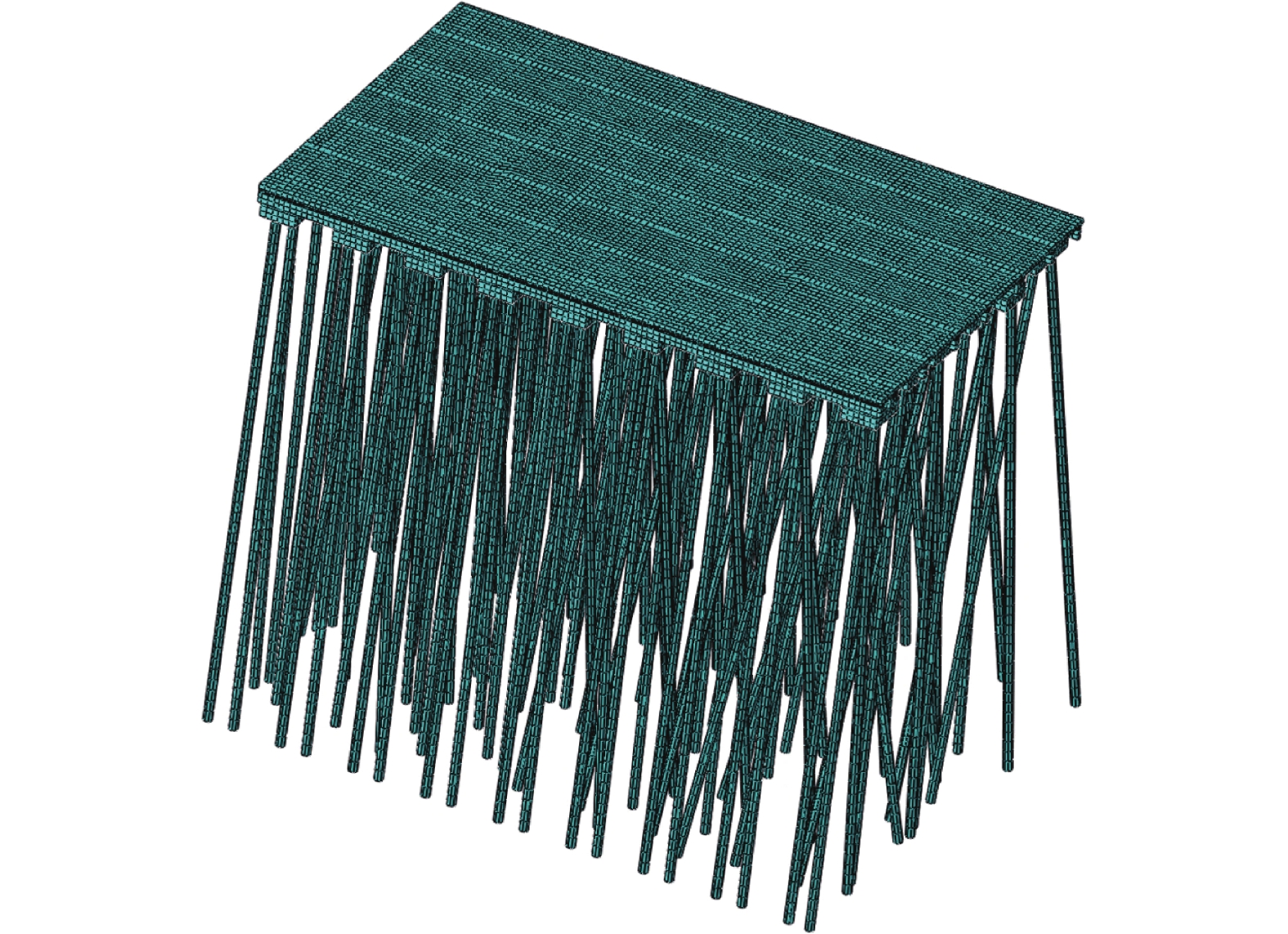
 下载:
下载:
